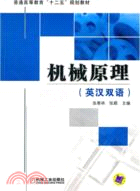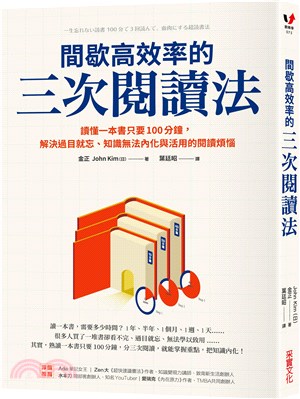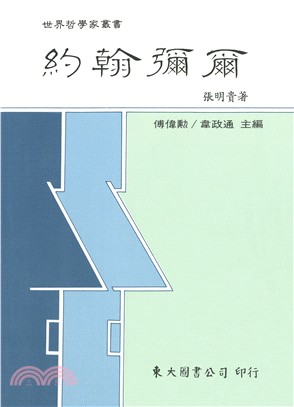機械原理(英漢雙語)(簡體書)
- 系列名:普通高等教育“十二五”規劃教材
- ISBN13:9787111360919
- 出版社:機械工業出版社
- 作者:張春林
- 裝訂:平裝
- 規格:26cm*19cm (高/寬)
- 出版日:2012/02/20
商品簡介
全書共有l3章。第1章介紹機械的基本概念;第2章到第4章,主要介紹機構結構分析、機構受力分析和機構運動分析;第5章到第9章,主要介紹常用機構的設計;第10章介紹空間機構和機器人機構;第11章介紹機構系統的設計;第12章和第13章主要介紹飛輪設計和平衡設計。創新設計的思想融于各章內容中。
《機械原理(英漢雙語)》的英文內容,在反映中文內容的前提下,采用典型的科技英語表現方式和通俗易懂的詞匯,簡便易讀。
《機械原理(英漢雙語)》可作為高等工科學校機械類專業的機械原理教材,特別適合作為英漢雙語教材,也可以作為機械工程人員的參考用書。
名人/編輯推薦
目次
Chapter 1 Introduction緒論1
1.1 General Information機械總論2
1.2 Teaching Content and Object of the Course機械原理課程的研究對象與內容6
1.3 Purpose of This Course學習機械原理課程的目的8
Chapter 2 Structural Analysis of Planar Mechanisms平面機構的結構分析11
2.1 Kinematic Chain and Mechanisms運動鏈與機構12
2.2 Schematic Diagram of Mechanisms機構運動簡圖16
2.3 Degree of Freedom of Planar Mechanisms機構自由度的計算22
2.4 Mechanism Analysis and Innovation機構分析與創新30
Chapter 3 Kinematic Analysis of Planar Mechanisms平面機構的運動分析41
3.1 Introduction 平面機構運動分析概述42
3.2 Velocity Analysis with Instantaneous Centers用速度瞬心法對機構進行速度分析44
3.3 Kinematic Analysis by Graphical Method用相對運動圖解法對機構進行運動分析48
3.4 Kinematic Analysis by Algebraic Method用解析法對機構進行運動分析60
Chapter 4 Force Analysis of Planar Mechanisms平面機構的力分析67
4.1 Introduction平面機構力分析概述68
4.2 Force Analysis Including Inertia Forces in Mechanisms計入慣性力的機構力分析68
4.3 Force Analysis Including Friction in Mechanisms計入摩擦的機構力分析76
4.4 Friction and Design of Selflocking Mechanisms摩擦與自鎖機構的設計88
Chapter 5 Synthesis of Planar Linkages平面連桿機構及其設計95
5.1 Characteristics and Types of Planar Linkages平面連桿機構的特點與基本型式96
5.2 Fundamental Features of Fourbar Linkages平面連桿機構的基本性質104
5.3 Synthesis of Fourbar Linkages平面連桿機構的設計112
Chapter 6 Design of Cam Mechanisms凸輪機構及其設計131
6.1 Introduction凸輪機構概述132
6.2 Basic Types of Follower Motion and Design從動件的運動規律及其設計138
6.3 Cam Profile Synthesis凸輪輪廓曲線的設計150
6.4 Sizes of Cam Mechanisms凸輪機構基本尺寸的設計158
6.5 Computeraided Design of Cam Mechanisms計算機輔助凸輪設計164
Chapter 7 Design of Gear Mechanisms齒輪機構及其設計171
7.1 Classification of Gear Mechanisms齒輪機構的分類172
7.2 Fundamental Law of Gearing齒廓基本定律174
7.3 Involute Properties and Involute Tooth Profiles漸開線齒廓及其嚙合特點176
7.4 Nomenclatures of Standard Spur Gear and Gear Sizes漸開線標準直齒圓柱齒輪的基本參數和幾何尺寸180
7.5 Meshing Drive of Standard Spur Gears漸開線直齒圓柱齒輪機構的嚙合傳動186
7.6 Forming and Undercutting of Gear Teeth漸開線圓柱齒輪的加工及其根切現象196
7.7 Nonstandard Spur Gears變位齒輪概述202
7.8 Parallel Helical Gears平行軸斜齒圓柱齒輪機構206
7.9 Worm and Worm Gears蝸桿傳動機構214
7.10 Bevel Gears錐齒輪機構220
Chapter 8 Design of Gear Trains輪系及其設計227
8.1 Classification of Gear Trains輪系及其分類228
8.2 Ratio of Ordinary Gear Trains定軸輪系傳動比的計算230
8.3 Ratio of Epicyclic Gear Trains周轉輪系傳動比的計算236
8.4 Ratio of Combined Gear Trains混合輪系傳動比的計算240
8.5 Some Considerations for Design of Planetary Gear Trains周轉輪系設計中的若干問題244
8.6 Introduction of Miscellaneous Planetary Trains其他類型的周轉輪系簡介252
Chapter 9 Introduction of Screws, Hooks Couplings and Intermittent Mechanisms螺旋機構、萬向聯軸器、間歇運動機構簡介259
9.1 Screw Mechanisms螺旋機構260
9.2 Universal Joints萬向聯軸器262
9.3 Ratchet Mechanisms棘輪機構264
9.4 Geneva Mechanisms槽輪機構268
9.5 Indexing Cam Mechanisms凸輪式間歇運動機構272
9.6 Intermittent Gear Mechanisms不完全齒輪機構274
Chapter 10 Spatial Mechanisms and Robotic Mechanisms空間連桿機構及機器人機構概述279
10.1 Introduction of Spatial Mechanisms空間連桿機構概述280
10.2 Introduction of Robotic Mechanisms機器人機構概述286
Chapter 11 Design of Mechanism Systems機構系統設計293
11.1 Introduction of Mechanism Systems機構系統設計概述294
11.2 Harmonization Design of Mechanism Motions機構系統的運動協調設計296
11.3 Combined Methods of Mechanism Systems機構系統的組合方法298
Chapter 12 Fluctuation and Regulation in Speed of Machines機械系統的運轉及速度波動的調節307
12.1 Operating Analysis of Machinery機械運轉過程分析308
12.2 Equivalent Kinetic Model of Mechanism Systems機械系統的等效動力學模型312
12.3 Kinetic Equations of Mechanism Systems機械系統的運動方程及其求解320
12.4 Periodic Speed Fluctuation and Regulation in a Machine周期性速度波動及飛輪設計324
12.5 Aperiodic Speed Fluctuation and Regulation in a Machine非周期性速度波動及其調節332
Chapter 13 Balance of Machinery機械的平衡337
13.1 Introduction 機械平衡概述338
13.2 Balance Design of Rigid Rotors剛性轉子的平衡設計340
13.3 Balance Test of Rigid Rotors剛性轉子的平衡實驗344
13.4 Balance of Planar Mechanisms平面機構的平衡簡介350
Appendix 附錄352
References 參考文獻362
書摘/試閱
The forces acting on the mechanism can be divided into two classes; they are external applied loads and the constraint forces. The external applied loads include the driving force and resistance etc. The constraint forces which occur in pairs are internal forces in the machine, but they can also be external forces on an individual link.
1. Contents of Force Analysis
1) Knowing the external applied loads, calculate the constraint forces which occur in pairs. Constraint forces can be used to design kinematic pairs.
2) Knowing the resistance acting on driven link, calculate the forces acting on driving link, or knowing the driving force, calculate the resistance acting on driven link.
3) The force analysis is the theoretical foundation to calculate the efficiency.
4) Make use of the force analysis, we can design some self-locking mechanism.
Various assumptions must be made during the force analysis. A major assumption concerns dynamic or inertia forces. All machines have masses, and if an element of a machine is accelerating,there will be inertia force associated with this motion. However, if the magnitude of the inertia force is small compared to the external applied loads, it can be neglected while analyzing the mechanism. Such an analysis is known as staticforce analysis.
When the inertia force due to the mass of the components is also considered, and the friction effects are negligible, it is called dynamicforce analysis.
In this chapter, we will discuss the static-force analysis considering the friction and dynamic force analysis considering the inertia force
主題書展
更多主題書展
更多書展本週66折
您曾經瀏覽過的商品
購物須知
大陸出版品因裝訂品質及貨運條件與台灣出版品落差甚大,除封面破損、內頁脫落等較嚴重的狀態,其餘商品將正常出貨。
特別提醒:部分書籍附贈之內容(如音頻mp3或影片dvd等)已無實體光碟提供,需以QR CODE 連結至當地網站註冊“並通過驗證程序”,方可下載使用。
無現貨庫存之簡體書,將向海外調貨:
海外有庫存之書籍,等候約45個工作天;
海外無庫存之書籍,平均作業時間約60個工作天,然不保證確定可調到貨,尚請見諒。
為了保護您的權益,「三民網路書店」提供會員七日商品鑑賞期(收到商品為起始日)。
若要辦理退貨,請在商品鑑賞期內寄回,且商品必須是全新狀態與完整包裝(商品、附件、發票、隨貨贈品等)否則恕不接受退貨。

























